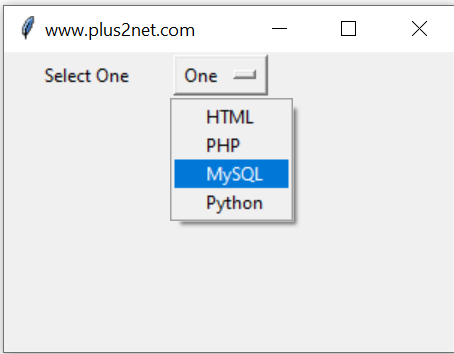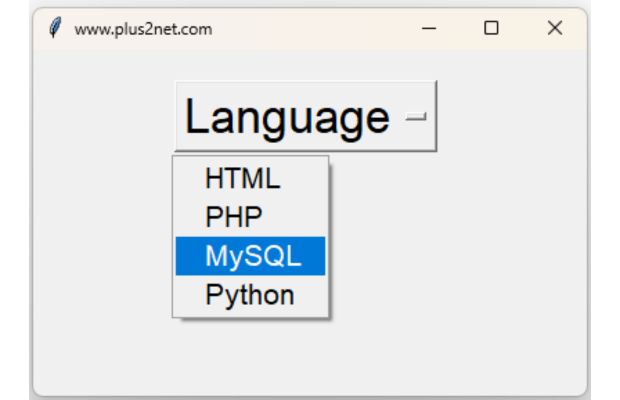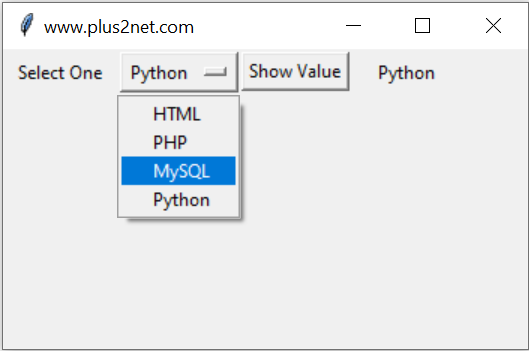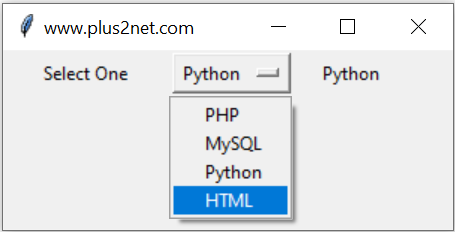Python tkinter OptionMenu


OptionMenu is similar to dropdown list box where user can expand and select one of the several available options.
Tkinter OptionMenu to show dropdown list box with options from List and dictionary values to users
Creating one OptionMenu
Using basics of Tkinter we will create one OptionMenu. (above Image )import tkinter as tk
my_w = tk.Tk()
my_w.geometry("300x200") # Size of the window
my_w.title("www.plus2net.com") # Adding a title
options = tk.StringVar(my_w)
options.set("One") # default selected value
l3 = tk.Label(my_w, text='Select One', width=15 )
l3.grid(row=5,column=1)
om1 =tk.OptionMenu(my_w, options, "HTML","PHP", "MySQL", "Python")
om1.grid(row=5,column=2)
my_w.mainloop() # Keep the window open*my_list to unpack the list return the elements as options. You can try the command print(*my_list) to display the elements of any list.
my_list = ["PHP","MySQL","Python","HTML"]
options = tk.StringVar(my_w)
options.set(my_list[1]) # default value
om1 =tk.OptionMenu(my_w, options, *my_list)
om1.grid(row=5,column=2)Using different font family and size for the menu & options

Managing font size of Tkinter OptionMenu #tkinter #fontsize
import tkinter as tk
my_w = tk.Tk()
my_w.geometry("400x250") # Size of the window
my_w.title("www.plus2net.com") # Adding a title
options = tk.StringVar(value='Language')
om1 =tk.OptionMenu(my_w,options,"HTML","PHP","MySQL","Python")
om1.grid(row=5,column=2,padx=100,pady=20)
menu = my_w.nametowidget(om1.menuname)# Get menu widget.
om1.config(font=['Arial',26]) # Set Menu Font
menu.config(font=['Arial',16]) # Set Option Font
my_w.mainloop() # Keep the window openSorting the Menu Options
Sorting a Listmy_list = ["PHP","MySQL","Python","HTML","JQuery"]
my_list.sort() # sort the list in alphabetical order
options = tk.StringVar(my_w)
options.set(my_list[0]) # default value
om1 =tk.OptionMenu(my_w, options, *my_list)
om1.grid(row=2,column=5) Adding a separator to the menu
om1['menu'].insert_separator(2) # add separator after 2nd elementHow to read selected option of OptionMenu
options.get() , here options is the textvariable of OptionMenu.
Tkinter OptionMenu reading selected option & updating label on click of button, trace of StringVar

We will use one Button and on Click of the Button we will display the selected option of an OptionMenu inside another Label.
To the above code we will add one more Button and one Label to display the selected value of the OptionMenu. We used the function my_show() to execute once the Button is clicked.
b1 = tk.Button(my_w, text='Show Value',command=lambda: my_show())def my_show():
str_out.set(options.get())import tkinter as tk
my_w = tk.Tk()
my_w.geometry("350x200") # Size of the window
my_w.title("www.plus2net.com") # Adding a title
options = tk.StringVar(my_w) # get the user selection from OptionMenu om1
options.set("Courses") # default value
l1 = tk.Label(my_w, text='Select One', width=10 )
l1.grid(row=2,column=1)
om1 =tk.OptionMenu(my_w, options, "HTML","PHP", "MySQL", "Python")
om1.grid(row=2,column=2)
b1 = tk.Button(my_w, text='Show Value', command=lambda: my_show() )
b1.grid(row=2,column=3)
str_out=tk.StringVar(my_w)
str_out.set("Output") # default text on Label l2
l2 = tk.Label(my_w, textvariable=str_out, width=10 )
l2.grid(row=2,column=4)
def my_show(): # Update the Label by using StrigVariable str_out
str_out.set(options.get()) # Update the label
my_w.mainloop() # Keep the window open On Select or On Change of option of OptionMenu

Without using any Button click we can read the selected value of the OptionMenu. Whenever any selection is changed or one option is selected by the user we will read the value and display the same through a Label.
trace method is used to attach 'observer' callbacks to the variable
More on StringVar & trace methodHere the variable options is connected to the OptionMenu, this value whenever changes ( when user select or change the option ) the trace method will trigger the callback function my_show().
Inside this function my_show() we will update the variable str_out ( which is connected to output Label l2) by reading the new assigned value of options i.e options.get().
def my_show(*args):
str_out.set(options.get())
options.trace('w',my_show)import tkinter as tk
my_w = tk.Tk()
my_w.geometry("300x120") # Size of the window
my_w.title("www.plus2net.com") # Adding a title
l3 = tk.Label(my_w, text='Select One', width=15 )
l3.grid(row=2,column=1)
my_list = ["PHP","MySQL","Python","HTML"]
options = tk.StringVar(my_w)
options.set(my_list[1]) # default value
om1 =tk.OptionMenu(my_w, options, *my_list)
om1.grid(row=2,column=2)
str_out=tk.StringVar(my_w)
str_out.set("Output")
l2 = tk.Label(my_w, textvariable=str_out, width=10 )
l2.grid(row=2,column=4)
def my_show(*args):
str_out.set(options.get())
options.trace_add('write',my_show) # triggers on change of StringVar options
my_w.mainloop() # Keep the window openUsing dictionary for OptionMenu
We have seen HTML drop down list box where the option attribute is collected but different value is shown to the visitor. So far we have used a single-element list to populate the OptionMenu here. Now we will use key value pairs or dictionary as options for the OptionMenu. Here is one sample dictionary from Category table where we have cat_id and category value as dictionary key , value pair.import tkinter as tk
my_w = tk.Tk()
my_w.geometry("250x200") # Size of the window
my_w.title("www.plus2net.com") # Adding a title
# create the dictionary
my_dict1={1: 'Fruits', 2: 'Colors', 3: 'Games', 4: 'Vehicles'}
options = tk.StringVar(my_w) # variable
options.set(my_dict1[1]) # default value
om1 =tk.OptionMenu(my_w, options, *my_dict1.values())
om1.grid(row=2,column=5)
def my_show(*args): # on select function
for i,j in my_dict1.items():
if j==options.get():
print(i)
options.trace('w',my_show)
my_w.mainloop()Dictionary keys updating a Label
This code creates a simple Tkinter GUI window with an option menu to select a language. The languages dictionary holds language names with their two-character codes as keys.
The OptionMenu displays available languages with "Spanish" as the default selection. When the selection changes, the my_show() function finds the selected language in the dictionary and updates the label with the corresponding language code. This change is handled using trace_add, which monitors changes to the options variable, ensuring the label is updated dynamically.
import tkinter as tk
my_w = tk.Tk()
my_w.geometry("250x200") # Size of the window
my_w.title("www.plus2net.com") # Adding a title
# create the dictionary
languages = {
"en": "English",
"es": "Spanish",
"fr": "French",
"de": "German",
"it": "Italian"
}
options = tk.StringVar(my_w) # String variable for OptionMenu
options.set(languages['es']) # default value to show
lb1=tk.Label(my_w,text='Language',width=10,bg='yellow')
lb1.grid(row=1,column=1,padx=5,pady=10)
om1 =tk.OptionMenu(my_w, options, *languages.values())
om1.grid(row=1,column=2)
def my_show(*args): # on select function
for i,j in languages.items(): # i= key & j = value
if j==options.get(): # Matches with the selected option
lb1.config(text=i) # Update the Label text with i
options.trace_add('write',my_show) # triggers on change in om1
my_w.mainloop()Listing all available options for configuration
print(om1.config().keys()) #om1 is the OptionMenuOptionMenu and Combobox key differences
Appearance: An `OptionMenu` widget displays the currently selected option in a label, while a Combobox widget displays the currently selected option in an `Entry` widget.User interaction: An `OptionMenu` widget requires the user to click on the label to open the drop-down menu, while a `Combobox` widget allows the user to simply start typing to open the drop-down menu.
Flexibility: A `Combobox` widget is more flexible than an `OptionMenu` widget, as it allows the user to enter any value, not just the values that are specified when the widget is created.
When to use an OptionMenu:
- Use an OptionMenu when:
- We have a limited number of options to choose from.
- We want to make it easy for the user to select one of them.
- Use a Combobox when:
- We have a large number of options to choose from.
- We want to allow the user to enter their own value.
Add or Remove options from OptionMenu Project 1
User can enter data in a text box and on click of a button the same data will be added as an option of an OptionMenu
Adding user entered text as Option of an OptionMenu.
Collect the unique class from student table of MySQL database by using Query. From the data create one list and use the same as option values of an OptionMenu
Create one OptionMenu with option values taken from MySQL database table
Create one OptionMenu with option values taken from SQLite database table Combobox Menu

Subhendu Mohapatra
Author
🎥 Join me live on YouTubePassionate about coding and teaching, I publish practical tutorials on PHP, Python, JavaScript, SQL, and web development. My goal is to make learning simple, engaging, and project‑oriented with real examples and source code.
Subscribe to our YouTube Channel here
This article is written by plus2net.com team.
https://www.plus2net.com

 Python Video Tutorials
Python Video Tutorials